| Year | Population |
|---|---|
| 1970 | 1,107 |
| 1980 | 1,398 |
| 1990 | 1,219 |
| 2000 | 1,270 |
| 2010 | 1,343 |
| Geographic Data | |
|---|---|
| N. Latitude | 45:07:26 |
| W. Longitude | 69:18:39 |
| Maine House | District 119 |
| Maine Senate | District 4 |
| Congress | District 2 |
| Area sq. mi. | (total) 39.7 |
| Area sq. mi. | (land) 38.5 |
| Population/sq.mi. | (land) 34.9 |
County: Piscataquis
Total=land+water; Land=land only |
|
[SANG-ehr-vil] is a town in Piscataquis County, incorporated on June 13, 1814 from the township T4 R6 NWP. It later ceded land to Guilford in 1889.
The area was settled almost eighty years earlier when Phineas Ames brought his family there in 1803. Shortly thereafter, William Farnham reportedly brought young apple trees from Garland and planted the first orchard.
Though called Amestown for Ames its earliest settler, upon incorporation it was renamed in honor of its early proprietor, Colonel Calvin Sanger of Sherborn, Massachusetts.
Bronze plaques mark the birthplaces of inventor Sir Hiram S. Maxim and mining tycoon Sir Harry Oakes, apparently a descendent of the Oakes family that had moved there by 1808.
Sangerville has been a small lumbering and agricultural community for most of its history. Adjacent to Guilford, its main village is just south of the Piscataquis River, which forms its northern boundary.
In the 1880’s Sangerville village hosted a grist mill, a sawmill, a tannery, and a woolen mill, which employed about fifty people. Elsewhere in town there were three sawmills, a shingle mill, and another grist mill.
The town has several ponds, the largest of which is Manhanock, accessible by a boat ramp off Route 23 near Sangerville village. Manhanock and Harlow (in Parkman) ponds are managed as one 595-acre water body since fish pass freely under a bridge separating the two.
The 403-acre Center Pond, a recreational area, is indeed in the center of the township and is accessible off the Silver Mills Road. The 93-acre Marr Pond is in East Sangerville.
 Congressional Medal of Honor Recipient:
Congressional Medal of Honor Recipient:
CHARLES A. CLARK; OTIS O. ROBERTS
Form of Government: Town Meeting-Select Board-Manager.
Additional resources
A Conspiracy of Crowns, The True Story of the Duke of Windsor, 1990
175th Anniversary Sangerville: Centeseptquinary, 1814-1989. Sangerville, Me. History Book Text Committee. 1989. [University of Maine, Raymond H. Fogler Library, Special Collections; Maine State Library]
Bailey, Parley A., 1822-1904. Correspondence, 1864-1865. (Cataloger Note: letters written to and from Bailey and his wife Judith, and from his daughter Mary while he was serving in the Civil War.)
Dover, Foxcroft, Guilford, Sangerville, Dexter, Newport, Corinna Souvenir 1908. 1908? University of Maine, Raymond H. Fogler Library, Special Collections]
Record Book of School Districts No. 3 and 5 in Sangerville, Maine, 1832-1848. [University of Maine, Raymond H. Fogler Library, Special Collections]
Sangerville Sesquicentennial 1814-1964: June 13, 1964. Maine. 1964. [Maine State Library]
Schultz, Sieferd C. Guilford and Sangerville. Charleston, SC. Arcadia Publishing. c2008.
*Maine. Historic Preservation Commission. Augusta, Me. Text and photos from National Register of Historic Places: http://pdfhost.focus.nps.gov/docs/nrhp/text/xxxxxxxx.PDF and http://pdfhost.focus.nps.gov/docs/nrhp/photos/xxxxxxxx.PDF
Carleton, Robert, House: 75000108.PDF
Sangerville Town Hall: 91000322.PDF
Varney, George J. A Gazetteer of the State of Maine. 1886. pp. 499-500.
National Register of Historic Places – Listings
Carleton, Robert, House
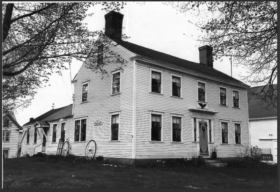 [North Main Street] The Robert Carleton House is an example of a late Federal style structure in an area generally settled after this style of architecture had passed into eclipse. Built about 1815, the house is valuable as an example of provincial Federal style architecture in a then largely unsettled region.
[North Main Street] The Robert Carleton House is an example of a late Federal style structure in an area generally settled after this style of architecture had passed into eclipse. Built about 1815, the house is valuable as an example of provincial Federal style architecture in a then largely unsettled region.
Sangerville was first purchased by John S. Foley in 1802, but not occupied. In 1807 it was sold to Col. Calvin Sanger of Sherbern, Massachusetts. The first settler, Phineas Ames from Hancock, N.H. had already taken up residence around 1802. Ames built a grist mill on Black Stream; another early arrival, Thomas Prince, established a fulling mill. One of the early workers in the mills was Guy Carleton. In 1818 he purchased the land where the house stands from Col. Sanger. Carleton had already begun to develop mill operations of his own in the area. Carleton Mills became a well-know name.
Within a year Guy Carleton sold the house and land to his brother Robert, who lived there until 1835. Robert Carleton was active in military affairs; he was elected Captain of the Sangerville Company. He later became Major and Colonel in the Fifth Regiment, First Brigade, Third Division. An interesting banner painted on unbleached muslin and dating from the Aroostook War of 1839 was found in the attic, proclaiming:
Volunteer Rendezvous Rally
Sons of Piscataquis!
Let me say that I am going with
my men and shall look faithfully
to their comfort and welfair.
W.S. Clark
Recruiting Officer
Sangerville Town Hall
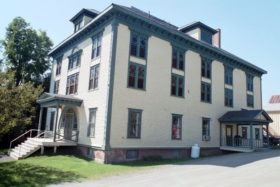 [Main Street] Sangerville’s Town Hall is among the most impressive to be found in Maine’s small communities. Built in 1902 the handsome two-story frame building exhibits a variety of Queen Anne and Colonial Revival style details.
[Main Street] Sangerville’s Town Hall is among the most impressive to be found in Maine’s small communities. Built in 1902 the handsome two-story frame building exhibits a variety of Queen Anne and Colonial Revival style details.
By mid-century the town had grown to 1,267 persons. Local industries included four tanneries, four shingle mills, three sawmills, and two gristmills. Judging by contemporary business directory listings, however, most livelihoods appear to have been made through agriculture. This pattern apparently persisted into the 1880s; a point that is illustrated by the steady population decline typical of such communities in the post-Civil War period in Maine.
However, between 1880 and 1890 Sangerville’s economic fortunes changed dramatically due to the establishment of two woolen factories. The new-found prosperity enabled the residents of Sangerville to build a seat of town government complete with a roomy auditorium that surpassed those of most of its peers.
Previously, town meetings were probably held in whatever space could be obtained. Town records were likely to have been stored at private residences, a common practice at the time. At the town meeting held in March 1901, $7,500 was authorized to acquire a building lot and erect the existing structure.
The town hall is one of a number of architecturally significant late 19th century buildings in Sangerville. Among these are a trio of Queen Anne houses featuring highly ornamented porches, and an elaborate Queen Anne church. Like the town hall, these buildings reflect the prosperity of the late 19th century.*


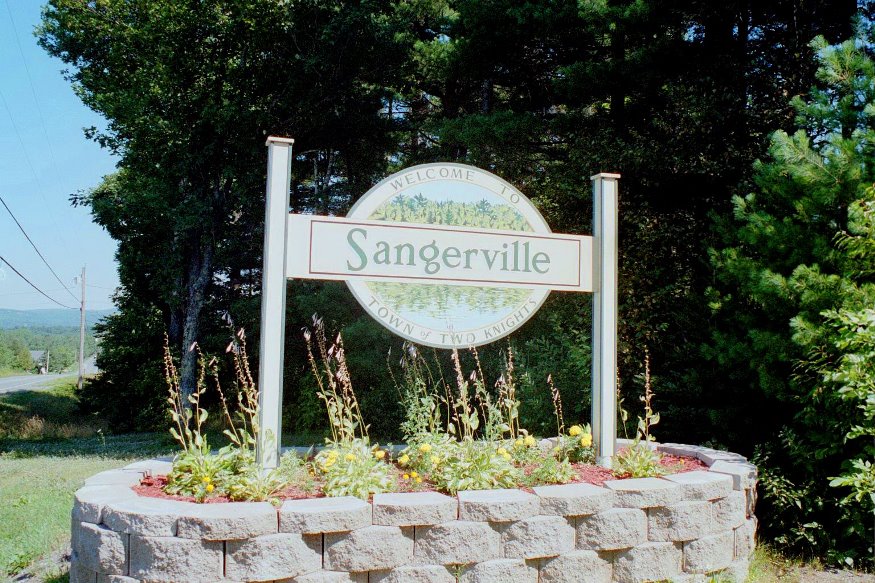
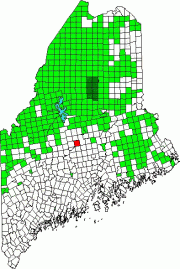

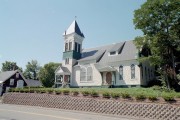
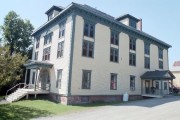

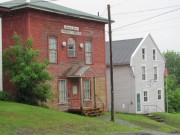

I enjoyed this but am looking for more info on the cabin Phineas Ames built ca 1802/3. I am a direct descendant of Phineas through six generations of Ames. Was surprised to run into an ancestor who was an original settler in Maine. Are there any photos of the old cabin?